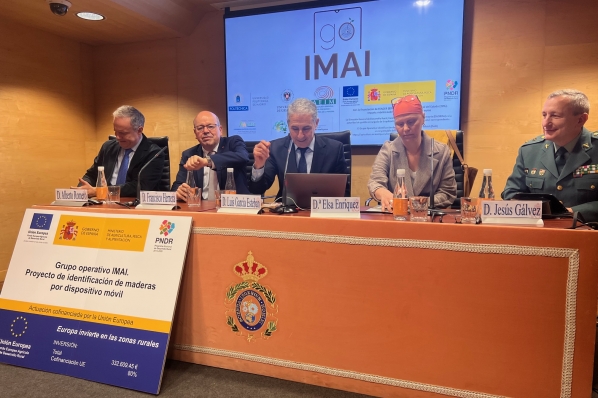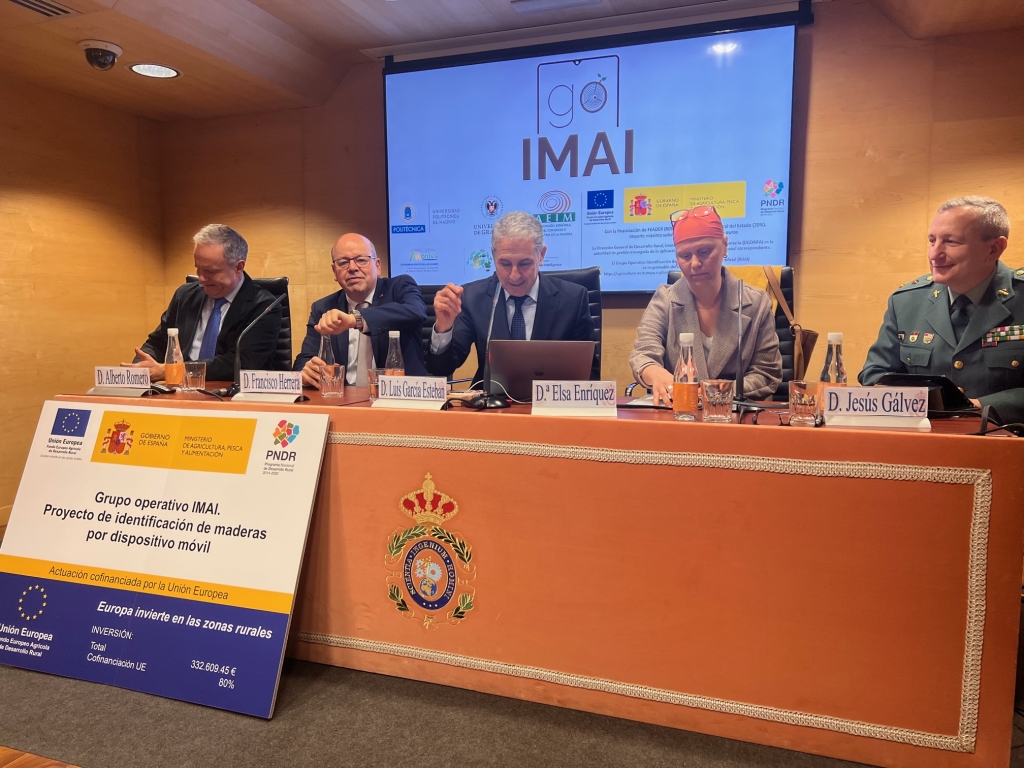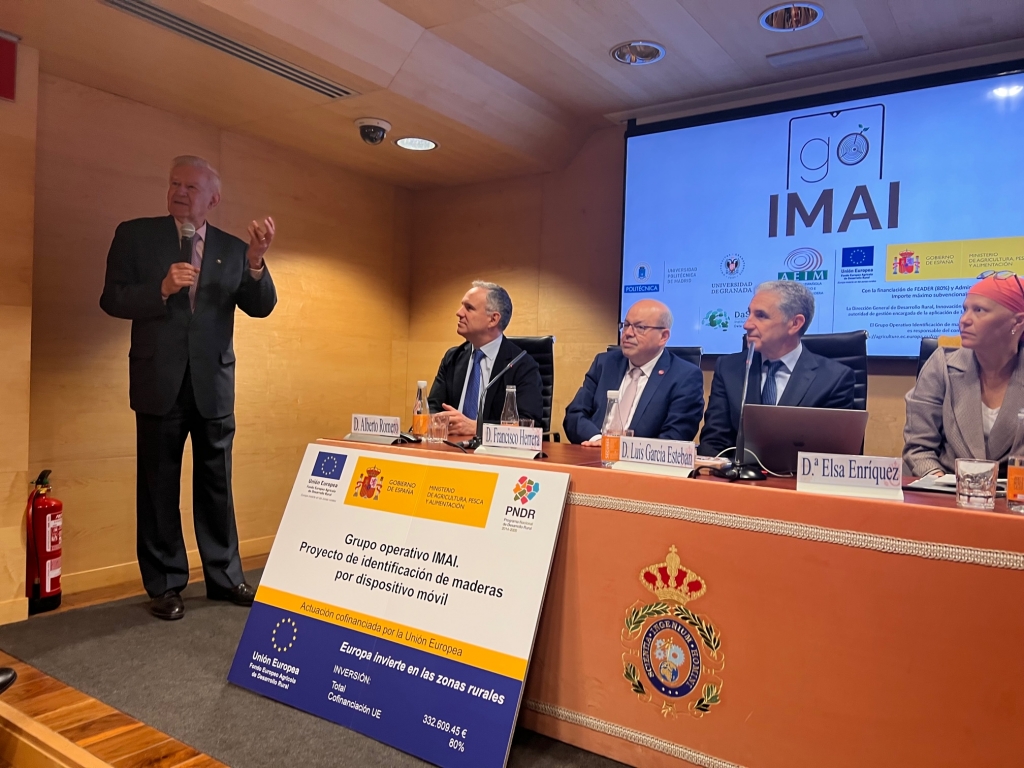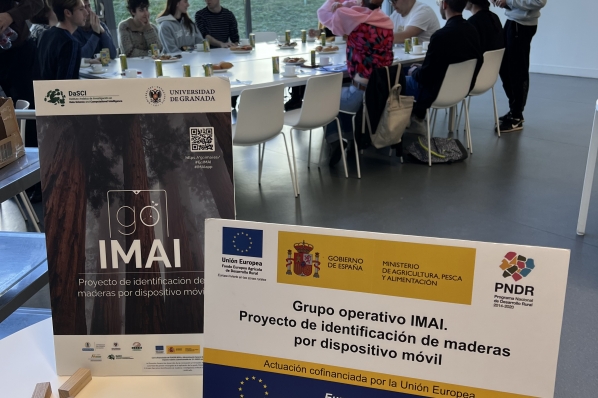
Launching an app that allows the identification of timber through mobile phones aided by artificial intelligence to facilitate the control of timber trade
The application for mobile devices developed by the Operational Group GO IMAI provides customs agents and law enforcement agencies with a tool that allows them to easily establish an early warning of a suspicious shipment. The Technical University of Madrid, the University of Granada and the Spanish Timber Trade and Industry Association (AEIM) make up the research team that has developed this tool over the last two years.

The objective of the IMAI Timber Identification and Artificial Intelligence Operational Group (GOIMAI) is to regulate the timber trade both in Spain and internationally by giving users, customs officials and law enforcement agencies, particularly those with competences in monitoring the trafficking of protected species (SEPRONA in Spain), a tool that allows them to issue an early warning when they suspect a shipment could contain illegally traded timber. The work of this group concluded with the presentation of an application for mobile devices based on artificial intelligence that will facilitate the control of the timber trade.
The results of the project were presented this morning at the Spanish Royal Academy of Engineering (RAING), in Madrid, by Elsa Enríquez Alcalde, deputy director general of Forestry Policy and Combating Desertification of the Spanish Ministry for Ecological Transition and Demographic Challenge; Luis García Esteban, director of the School of Forestry Engineering and Natural Resources (ETSIMFMN); Francisco Herrera Triguero, professor of the Department of Computer Science and Artificial Intelligence of the University of Granada; Alberto Romero Cagigal, secretary general of the Spanish Timber Trade and Industry Association (AEIM), and Jesús Gálvez Pantoja, lieutenant colonel and head of the Spanish Civil Guard's Central Operational Unit for the Environment (UCOMA) at the Headquarters of the Nature Protection Service (SEPRONA). During the event, Rosana Montes Soldado, professor at the Department of Software Engineering of the University of Granada, gave a demonstration of the developed application.
The Technical University of Madrid (UPM), the University of Granada (UGR) and the Spanish Timber Trade and Industry Association (AEIM) together form GO IMAI, a Operational Group whose results represent a significant advance for transparency in the international timber trade. The work of GO IMAI began in May 2021 and is co-funded by the Spanish Ministry of Agriculture, Fisheries and Food and the European Agricultural Fund for Rural Development (EAFRD), within the 2020 Call for Innovation Projects, in which they obtained the highest score of all the initiatives presented.

Need for the project
This project arose from the need on the part of customs agents, public administration inspectors and state security forces, especially the Spanish Civil Guard's Nature Protection Service (SEPRONA), for a tool that would allow them to establish an early warning of suspicious shipments of illegally traded timber.
At the present time, it is not possible to identify timber at a merely macroscopic level, and the intervention of highly specialised personnel is required for a reliable and expert identification. Given these circumstances, coupling knowledge of macroscopic wood anatomy and artificial intelligence has allowed GO IMAI researchers to design and implement a tool that facilitates this identification for law enforcement agents in a simple and fast way.
The project also aims to address other societal challenges in order to contribute to the conservation of forests and their biodiversity and thus to mitigate the effects of climate change insofar as the environmental effects of illegal logging include deforestation and biodiversity loss. The World Bank estimates that governments around the world lose between 10 and 15 billion dollars each year because of illegal logging.
In addition, estimates by the Intergovernmental Panel on Climate Change (IPCC) indicate that global deforestation has a negative impact on climate change, accounting for 15% to 20% of global greenhouse gas emissions.
This situation increases the need to prevent the trade of timber, both at origin and destination without legal certification. In this sense, the mobile application developed will provide authorities with a free resource to monitor compliance with international timber trade regulations, both in relation to the EU Timber Regulation (EUTR), which will be replaced by the EU Deforestation Regulation (EUDR), and the Convention on International Trade in Endangered Species of Wild Fauna and Flora (CITES). It will also be an excellent tool for professionals, researchers and hobbyists.
Almost two years of work
The results now obtained are the culmination of almost two years of joint effort and the experience of researchers in the fields of wood anatomy and artificial intelligence. GO IMAI has developed an intelligent technological solution that recognizes in seconds a wood species with a high accuracy rate just from a photograph taken with a magnifying lens attached to a mobile phone.
During the process, the team documented and photographed 400 wood species with a variety of mobile phone cameras and magnifying lenses to determine the most useful information settings. The problem domain was then analyzed and a methodology was proposed to optimize the quality pre-processing of the macroscopic wood images taken to train the intelligent classification system after data segmentation and augmentation processes.
Subsequently, the model was optimized on the basis of artificial deep neural networks or 'deep learning' to enable its execution on the device itself during the classification process from an image of the sample without recourse to cloud computing, thereby saving communication costs with servers.
The two applications developed for iOS and Android are native and free.
The project has also included two usability tests to obtain information on the user-friendliness of these two applications taking into account accessibility aspects.
GO IMAI has implemented a web database with which complete information on more than 400 species has been documented and which can be consulted from the apps thanks to the use of more than 40 different filtering options, which allows access to the record of a species not merely as a result of the AI model prediction. Once published, the app will be available for use by customs officers and law enforcement agencies.
GO IMAI in figures
The intelligent system developed by GO IMAI has worked with a high volume of macroscopic images, 19,340 in total, with a resolution of 4,000×3,000 pixels, from the sampling of 531 wood species and using 5 different magnifying lenses. During the months of experimentation, the project generated and discarded 50 different models, which involved some 600 hours of training on a high-performance computing system.
The model has considered an average of 12 raw samples for each class, and during an advanced optimization phase 28 additional models have been generated, totalling 280 hours of training.
The calculations performed in the training (applying scripts with different objectives) modify the original data in various ways to obtain an increase in data (5 steps) and to improve quality (3 steps). These modifications perform greyscale changes, equalisation, change of brightness, contrast and saturation, rotation, cropping and scaling.
Programming has been tackled using Python and Kotlin languages, and the apps' own development languages on iOS and Android.
Libraries used:
Tensorflow 2.9.1
Tensorflow addons 0.15.
Pandas 1.4.0
Numpy 1.23.5
Scikit learn 1.0.2
Pillow 9.0.1
Opencv 4.5.5
And up to 300 packages installed as dependencies
GO IMAI members
The project is part of the Spanish National Rural Development Programme and is funded by the EAFRD (European Agricultural Fund for Rural Development) (80%) and the Spanish General State Administration (20%). The Technical University of Madrid (UPM), the University of Granada (UGR) and the Spanish Timber Trade and Industry Association (AEIM) are the beneficiaries. The Descubre Foundation, Everyware Technologies, Donosti Frame and José Luis Fermosel Álvarez are subcontractors of the initiative.
The Spanish General Directorate of Rural Development, Innovation and Agri-Food Training (DGDRIFA) is the managing authority responsible for the implementation of the corresponding EAFRD and national aids.
The IMAI Timber Identification and Artificial Intelligence Operational Group (GO IMAI) is responsible for the content published on this website.
https://agriculture.ec.europa.eu/common-agricultural-policy/rural-development_es



